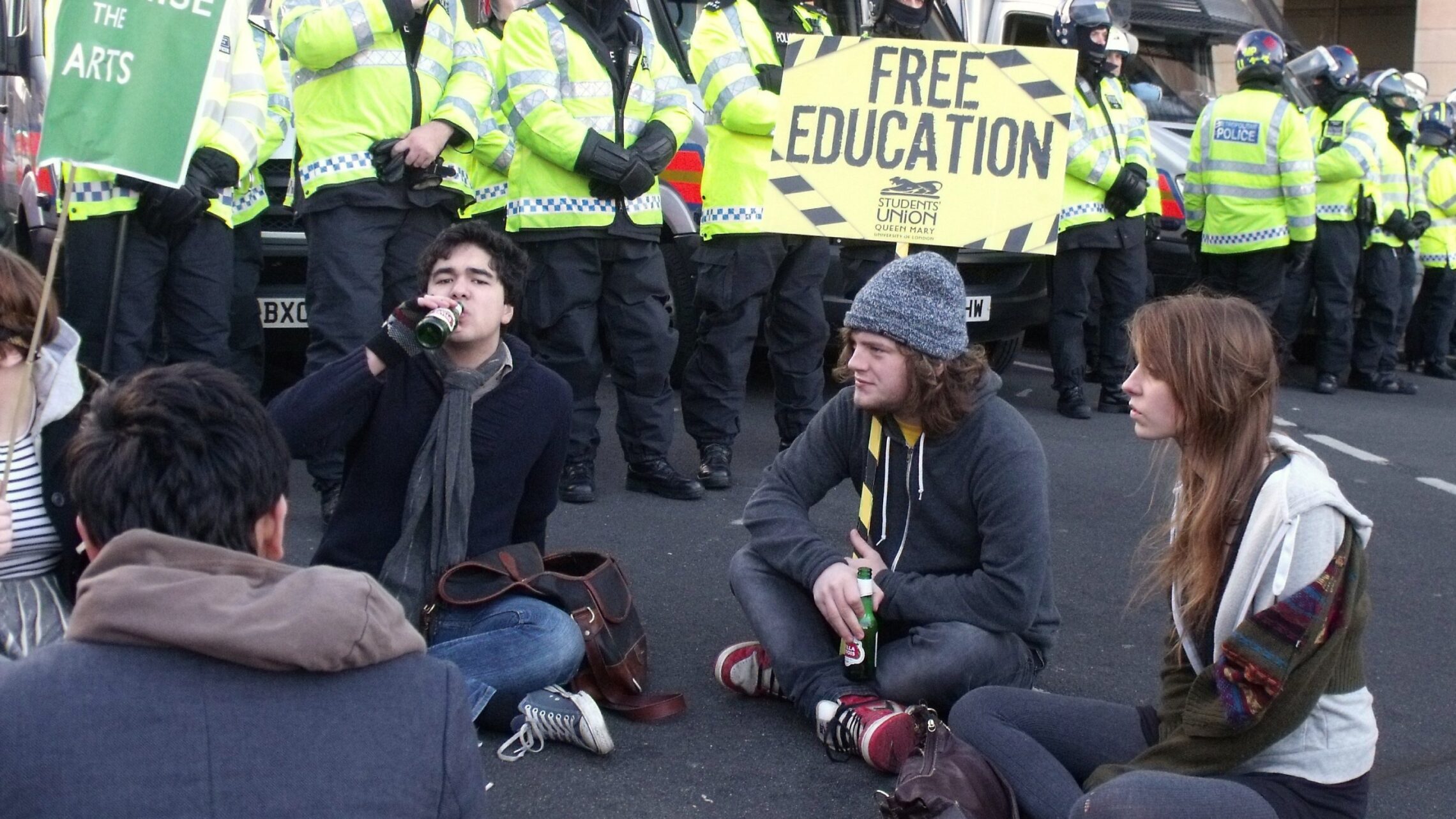By and large, the broad sweep of activities badged as “student politics” has little direct impact on the outside world.
Within the “partnership” model of student unionism, a competent officer may achieve piecemeal reform to a university’s welfare provision or library opening hours. “Wins” can be chalked up, and CVs can be enhanced.
But if you view the rising tide of marketisation, precarious work and debt as a problem – which, on paper at least, almost all students’ unions do – these efforts are a palliative administered to a sector in decline.
Even at its more radical end, student activism often ends up being more about legacy and training than it is about getting results at the time. There is nothing wrong with this per se, and we should not underestimate its reach – in an era of left-leaning youth and mass participation, campaigns for strike solidarity, trans rights and climate justice are a way to find, educate and recruit millions of people.
Under siege
There have been moments, though, when student protest has qualitatively changed politics. In the autumn of 2010, students found themselves at the sharp end of the Coalition government’s austerity programme. This was a period in which the left was utterly marginalised, and in which young people were widely derided as apathetic.
But as Cameron and Clegg moved to scrap the Education Maintenance Allowance in FE and triple tuition fees in HE, hundreds of thousands of students mobilised for four days of action and dozens of campuses hosted occupations.
It began with the occupation of Millbank Tower on November 10th, and ended on December 9th with thirty thousand students penned into Parliament Square facing escalating police violence as MPs passed the fee rise.
Despite its immediate defeat, the student movement of 2010 provided a spark which accelerated the re-emergence of the left as a mainstream political force in Britain (and in a way that the leaderless, anarchic movement after Millbank would never have predicted).
By early 2011, the trade unions had begun to move, and that year saw a much wider revolt encompassing Occupy, mass strike action over pensions, local anti-cuts groups and big, chaotic demonstrations on the streets of London.
Millions were politicised by this wider moment, and it was from its fragments that Jeremy Corbyn rose a few years later. My book tells the story of that process, and what happened to those fragments inside Labour.
A parallel universe
From the perspective of the mass movements that emerged, the first half of the 2010s were marked not just by the failure of the banking sector and the political elite, but by the failure of our own institutions as well. The Labour Party in this era supported austerity. The leaderships of a number of major unions sold short the 2011 pensions dispute just as it looked like it might be about to force a government retreat.
But it was NUS that faced the first test, and it drew heavy criticism. Following the occupation of Millbank Tower, the NUS leadership went out of its way to tell SUs not to show up for further days of action. In the following years, NUS remained resistant to mobilisation, despite no shortage of government-led marketisation and attacks on the sector. It was often left to grassroots coalitions like the National Campaign Against Fees and Cuts – for which I was one of the organisers – to coordinate student protest.
I once thought that leaving higher education and the student movement would make me see the NUS of my era in a different light – but more perspective has only made it seem weirder. As angry students mobilised and Lib Dem politicians tore up their pledges, NUS built a barrier between itself and the movement in the streets. As the centrism of the New Labour era gave way to a mass radicalisation of young people, it focussed on lobbying – aimed largely at Tory ministers and university managers who didn’t want to hear it.
Successful organisations punch above their weight, and are more than the sum of their parts. NUS had no shortage of talented people and strategists, and led a movement with hundreds of elected full time officers and bases all over the country. It had, on paper, about as many members of the TUC, many of whom were up for a fight. But while higher education was engulfed in a battle for its soul, NUS played host to a carnival of sector jargon experts, sports and fundraising advocates, and “quality geeks”. They were all perfectly nice, and many were good at what they did, but it felt like we were living in parallel universes.
To a great extent, the relative conservatism of SUs in the first half of the 2010s was a product of the phenomenon of political microclimates that affects the British student movement. It took some time for the defeats of the miners’ strike era to be reflected in higher education, with students continuing to mobilise in relatively high numbers into the 1990s. But when supporters of New Labour finally did take over NUS, their reign continued some years after the end of the project within Labour itself. It was only in 2014 that the national union finally began to advocate for free education, after years of supporting a graduate tax.
Corbynism and all that – or not all that
The rise of Corbynism in the middle of the decade ought to have provided the conditions for a resurgence of student mobilisation, and should have built the infrastructure to enable the student movement to play a leading role in the next wave of social and industrial struggle. The student climate strikes should have populated UK universities with multiple cohorts of ready-made activists and rebels.
The student left, in the broadest sense of the term, held the NUS Presidency for a number of years. A number of big direct action campaigns have sprung up, most notably around housing and solidarity with the UCU strikes. But with a mass movement brewing over the Cost of Living crisis, students are, for the moment, largely absent on their own terms.
There are a number of obvious external factors in why students are lower profile in 2022 than they were in 2010 – higher education is not the first battleground of post-crash austerity in the same way, and the pandemic has had a legacy of demobilisation in a number of sectors.
But to really understand what’s going on, you have to look a bit deeper than that, firstly at the culture of official Corbynism. While the rise of the new Labour left represented an advance for supporters of free education, and vastly expanded the pool of politically active young people, it also had the effect of sucking the energy out of social movements and pushing people towards the tasks of knocking on doors, taking over Constituency Labour Parties, and cheering on the Labour leadership.
By and large, it recruited footsoldiers rather than activists, and while its supporters were capable of capturing positions in the official structures of both Labour and NUS, they lacked either the will or the means to engineer social movements “from above”.
The death of factions
The “Labourist” turn on the British left coincided with the collapse of organised factions in the student movement. In the early 2010s, the National Campaign Against Fees and Cuts had a strong network of campus activist groups – it held an annual democratic conference and a regular programme of activist training events.
The Socialist Workers’ Party had thousands of members, and was strong in HE. While these groups were never more than a third of national conference between them, they were the driving force behind a lot of activism and pushed the NUS from the outside.
The SWP’s student base collapsed following the Comrade Delta crisis in 2013, and NCAFC went into terminal decline from 2015, as Labour Clubs became the natural collecting point for left-inclined new students. The Liberation Left has been strong electorally, but functions more as a network within the bureaucracy than as an activist base for the student movement.
Progress-via-Labour Students, the traditional core of the right in NUS, ceased to be effective in the era of Corbynism. In the absence of standing factions, activist politics within the student movement has lacked institutional memory and a consistent national focus. The basic activity of the student left in recent years has been building solidarity with the UCU – an important task, but often something which amounts to a spectator sport if you don’t have a wider mobilisation plan.
Tipping points
The student movement is strong when it is an antagonistic mix of political priorities and ideas – and one of the crucial problems is that those ideas lack a battleground. NUS was never a glittering beacon of intellectual exchange, and people like me moaned about it endlessly – but it did provide a space for politics to happen, and it was always significant in terms of building turnout for student mobilisations.
If you could get NUS to call a national demonstration, the logic of the student left always went, it would do some heavy lifting and you might get a wave of action and occupations off the back of it. But NUS’ funding crisis has seen the organisation shrink to a fraction of its former size in terms of staff and officer posts. It no longer even has a national executive, and whatever it did in the 2010s to mobilise SUs to protest, it isn’t doing now – and not for lack of will on the part of its officers or staff.
When we marched in 2010 and the years that followed, we always talked about tipping points. If the marketisation and “value for money” logic could get into the system, it would not only wreck education as a public service, it would denude our ability to resist future attacks.
The defeats of the 2010s were the beginning of a process of depoliticisation in higher education that cannot be reversed without a concerted strategy and a lot of resources. But if the experience of 2010 told us anything, it was that students are quite capable of exploding at moments when they are thought to be inert. This cohort of students is bigger and on average more politically radical than we were – what it needs now is a spark and a plan.
This Is Only The Beginning: the making of a new left from anti-austerity to the fall of Corbyn, is out now with Bloomsbury. You can buy it here.



















I know Michael understands some of the point I am making, but I despair at the conflation of England with “Britain” with the “UK” state in many of the writings of erstwhile leaders of the left over the last decade. 2010 actually also marked the beginning of the current era of “partisan vertical incongruence” as Malcolm Harvey described the current political state of UK governance, particularly over devolved matters such as higher education. What Harvey meant in layperson’s language is that for the first time in 2010 no political party had governing power in more than one of the UK’s… Read more »